|
Organizing History
|
|
Unexplored monuments from Punjab and Haryana are being documented by a group of Indian and American archaeologists and researchers on a grant from the U.S. State Department’s Ambassadors Fund for Cultural Preservation
|
By RICHA VARMA
Photographs courtesy: Centre for South Asian Art & Archaeology
|

From far left: The Mughal Garden in
Pinjore, Haryana. Belonging to Fidai Khan Koka, the supervisor of the Badshahi mosque in Lahore, Pakistan, it is the only terraced garden of the 17th century that has survived in the
Haryana-Punjab region; the Hazrat Shah Najm-al-Haq mosque and tomb complex in
Sohna, Haryana; Sheikh Chilli's tomb and madrasa in
Thanesar, Haryana; a Mughal caravan resting stop in
Gharunda, Haryana ; Mughal Sarai in Ludhiana, Punjab, is one of the few caravan resting stops built along the old Agra-Lahore route which are still in good shape; the tomb of Shagird in
Sirhind, Punjab; glazed tile work on the western gateway of Sarai Amanat Khan in
Amritsar, Punjab. It was built by Amanat Khan, the calligrapher of the Taj Mahal
|
|
|
Over the past 18 months, a team of Indian and American researchers, art historians, archaeologists, photographers and surveyors has been sweating it out in the dusty plains of Punjab and Haryana doing what is any art or history lover’s dream—exploring and archiving lost treasures of an old civilization.
Funded by the U.S. State Department’s Ambassadors Fund for Cultural Preservation, the project covers 136 monuments at 33 sites. Working on a grant totaling $93,914, the project is being handled by the Centre for South Asian Art & Archaeology. Based in New Delhi and Gurgaon, Haryana, the center (http://www.indiastudies.org/) is documenting unexplored Indo-Islamic monuments in the hinterland of the Grand Trunk Road in the two states, says project director Vandana Sinha.
While certain areas, such as those around New Delhi, are extensively studied, many others such as this region had barely been explored or even identified.
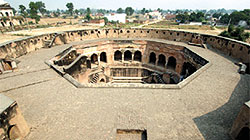 |
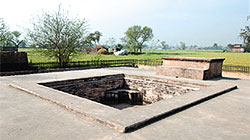 |
|
Baoli Ghaus Ali Khan in Farrukhnagar, Haryana. The octagonal shape of the step-well, or baoli, makes it unique in this region where a preference for rectangular step-wells is seen |
The Takht-e-Akbari or Akbar's throne in Kalanaur, Punjab. The monument marks the site of Mughal Emperor Akbar's coronation in 1556 |
Comprising Indo-Islamic monuments from the 12th through the 19th centuries, the Punjab-Haryana landscape is dotted with an array of heritage buildings such as the mosque at Panipat, built by the founder of the Mughal dynasty, Babur, or the caravan resting stops at Nur Mahal, built by Nur Jahan, wife of Emperor Jehangir. There are also a number of bridges, distance markers (kos-minars), pleasure gardens, rest houses, forts and palaces. While there are more than 200 possible sites in the two states, about 35 representative sites were selected in consultation with the center’s scholars and art historians who have worked in the area. These include historians from the Government Brijindra College in Punjab, the Universities of Minnesota and Texas and the American Institute of Indian Studies at Gurgaon. Permission was obtained from the Archaeological Survey of India and Departments of Archaeology of the two states.
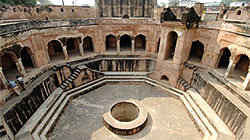 |
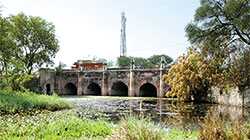 |
|
View of Baoli Ghaus Ali Khan from the rooftop. The interior shows the tank and well in the center and the corridor around the tank |
Mughal Bridge in Sirhind, Punjab. Many such bridges were constructed in the 16th and 17th centuries on the Agra-Lahore route to facilitate caravans |
In the end, high quality and detailed monument plans, architectural elevations and photographs of these structures will be accessible to a wider audience, including on the Internet. Much work has already been completed.
The project “was not limited to photographing the specific monuments but the emphasis was on documenting the surroundings also in order to see the settings of these structures in the context of their current environment,” says Sinha. “Such an approach was adopted to be able to collect critical information about such monuments that would aid understanding of the layers of the ‘landscape.’ ”
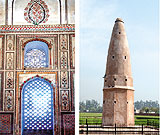 |
| The interior of the tomb of Afghan Emperor Ahmedshah Abdali's grandson Shah Zaman in the Rauza Sharif Complex in Sirhind, Punjab |
A kos-minar or distance marker near a caravan resting place in Kot Panech, Punjab. The pillars were built on travel routes to mark distance traveled and were placed at intervals of one kos, approximately 4.17 kilometers |
The Ambassadors Fund was created by the U.S. Congress in 2001. Since then, it has provided direct grants for more than 550 projects in 100 countries representing a contribution of more than $20 million toward the preservation of cultural heritage worldwide.
—Courtesy SPAN
|